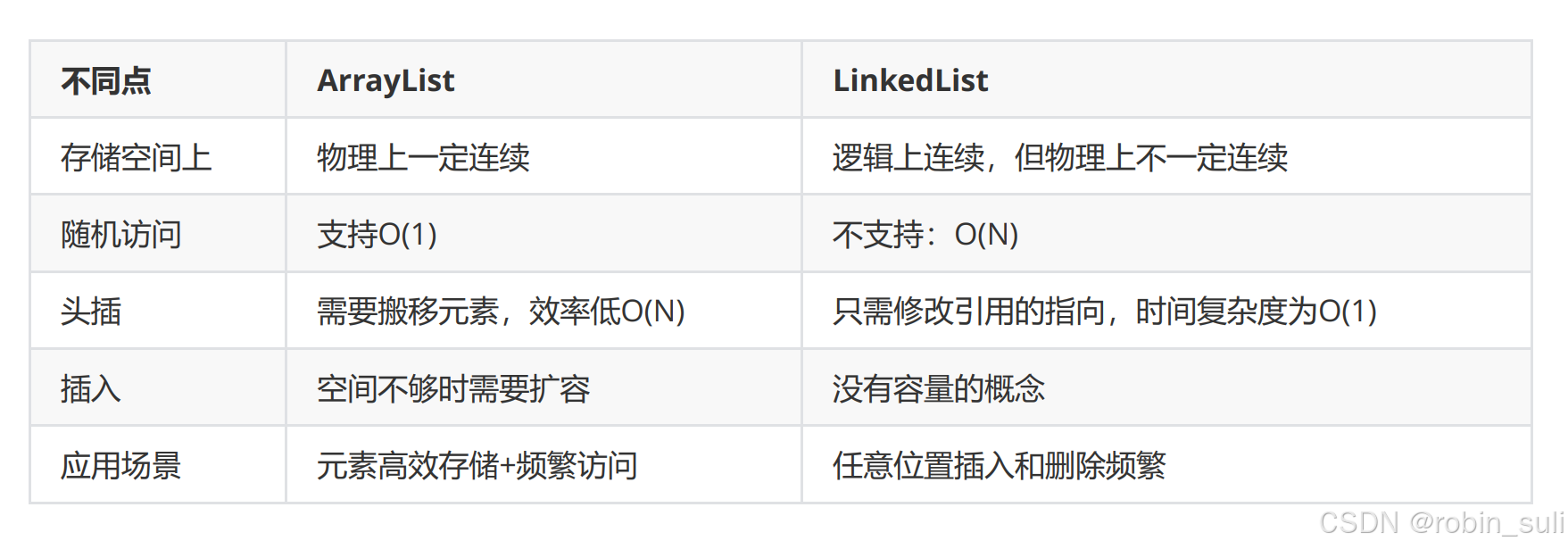 一.ArrayList的缺陷:1.ArrayList底层使用数组来存储元素,如果不熟悉可以来再看看:ArrayList与顺序表-CSDN博客由于其底层是一段连续空间,当在ArrayList任意位置插入或者删除元素时,就需要将后序元素整体往前或者往后搬移,时间复杂度为O(n),效率比较低,因此ArrayList不适合做任意位置插入和删除比较多的场景。因此:java集合中又引入了LinkedList,即链表结构。二.链表1.链表的概念及结构:链表是一种物理存储结构上非连续存储结构,数据元素的逻辑顺序是通过链表中的引用链接次序实现的就像一个火车。
一.ArrayList的缺陷:1.ArrayList底层使用数组来存储元素,如果不熟悉可以来再看看:ArrayList与顺序表-CSDN博客由于其底层是一段连续空间,当在ArrayList任意位置插入或者删除元素时,就需要将后序元素整体往前或者往后搬移,时间复杂度为O(n),效率比较低,因此ArrayList不适合做任意位置插入和删除比较多的场景。因此:java集合中又引入了LinkedList,即链表结构。二.链表1.链表的概念及结构:链表是一种物理存储结构上非连续存储结构,数据元素的逻辑顺序是通过链表中的引用链接次序实现的就像一个火车。 注意:1链表在逻辑上是连续的,在物理结构上不一定连续。 2.节点一般都是从堆上申请出来的 3.从堆上申请出来空间,是有它的分配规律和策略的,两次申请出来的可能连续也可能不续2.链表的分类: 单向或者双向, 循环和非循环, 带头和不带头就可以组合出8种类型的链表。 虽然有这么多的链表的结构,但是我们重点掌握两种:(1)无头单向非循环链表:结构简单, 一般不会单独用来存数据。实际中更多是 作为其他数据结构的子结构,哈希桶、图的邻接表等等。另外这种结构在笔试面试中出现很多。 (2)无头双向链表:在Java的集合框架库中LinkedList底层实现就是无头双向循环链表
注意:1链表在逻辑上是连续的,在物理结构上不一定连续。 2.节点一般都是从堆上申请出来的 3.从堆上申请出来空间,是有它的分配规律和策略的,两次申请出来的可能连续也可能不续2.链表的分类: 单向或者双向, 循环和非循环, 带头和不带头就可以组合出8种类型的链表。 虽然有这么多的链表的结构,但是我们重点掌握两种:(1)无头单向非循环链表:结构简单, 一般不会单独用来存数据。实际中更多是 作为其他数据结构的子结构,哈希桶、图的邻接表等等。另外这种结构在笔试面试中出现很多。 (2)无头双向链表:在Java的集合框架库中LinkedList底层实现就是无头双向循环链表 3.无头单向非循环链表实现: 自己定义的类和包:
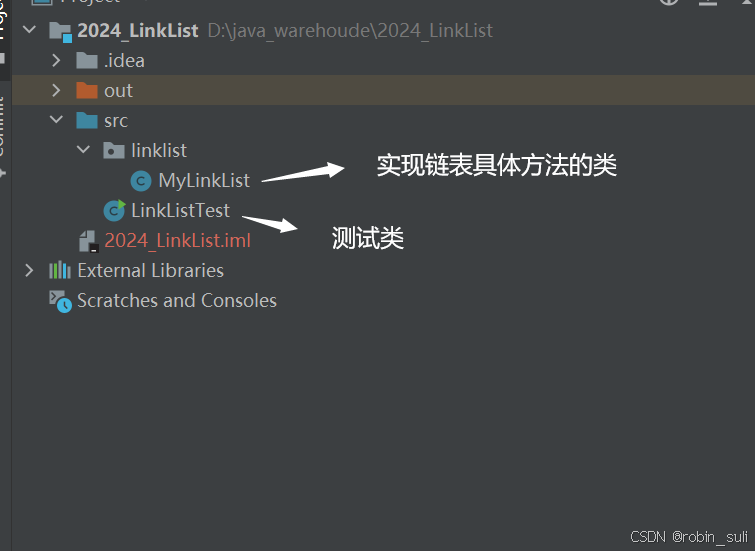
这里可以把方法先写在一个接口中,再通过MyLinkList实现接口,这样写可能更好,代码好复用。 我们 MyLinkList类中:我们要先抽象出每一个节点,每一个节点就是一个对象,我们可以写一个产生节点对象的模板:(这里可以定义一个静态内部类,来抽象出节点模板):
public class MyLinkList { public int data; public MyLinkList.Node next; //静态内部类 public static class Node { public int data;//0 public Node next;//引用类型默认值为NULL public Node(int data) { this.data = data; } } }public void addFirst(int data) { //第一次插入节点(链表为空) if (this.head == null) { Node node = new Node(data);//链表头为空时(head == null),整了链表的头引用为 node this.head = node; return; } //链表不为空,单链表插入要先绑后面 Node node = new Node(data); node.next = this.head; head = node;//把node的引用给head,然head变成新的头 }(2)尾插法:
public void addList(int data) { //第一次插入时 if (this.head == null) { Node node = new Node(data); head = node; return; } Node node = new Node(data); Node cur = this.head;//cur从头开始 /*这里注意cur不可以先走到空,如果cur走到null,那么cur的next就是cull*/ while (cur.next != null) { cur = cur.next; } //出来时cur==null,就尾插 cur.next = node; }(3)打印单链表:这里我们可以写一个,重载方法display2,可以让链表从返回的某个节点开始打印;
//打印单链表 public void display2(Node nodeH) { Node cur = this.head;//cur从头开始 cur = nodeH; while (cur != null) { System.out.print(cur.data + " "); cur = cur.next; } System.out.println(); } public void display() { Node cur = this.head;//cur从头开始 while (cur != null) { System.out.print(cur.data + " "); cur = cur.next; } System.out.println(); } (4)查找链表中是否包含某一数据节点:
//查找是否包含关键字Key,是否在链表中 public boolean contains(int key) { Node cur = this.head; while (cur != null) { if (cur.data == key) { return true; } cur = cur.next; } return false; }(5)清空链表:
public void clear() { Node cur = head; while (cur != null) { //注意定义一个,变量记住置为空的,后驱节点 Node curN = cur.next; cur.next =null;//引用类型必须制空 cur = curN; } //最后把头节点手动置为null head = null; }(6).返回链表的长度:
public int size() { Node cur = this.head; int count = 0;//count不能为1,如果是空链表,count=1返回就,寄了 while (cur != null) { cur = cur.next; count++; } return count; }(7)任意位置插入:这里我画了个图来理解:
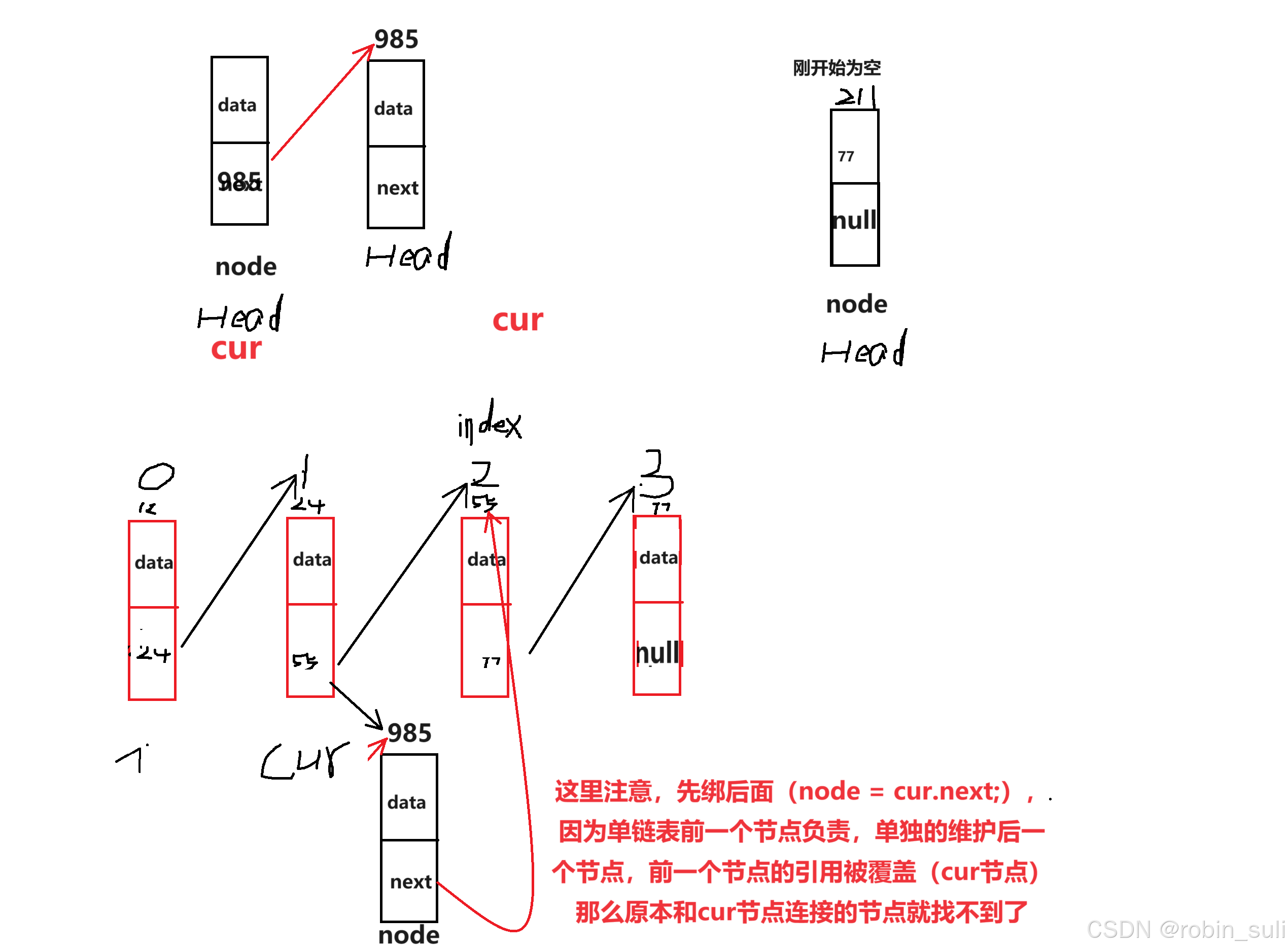
//任意位置插入(第一个数据节点为0号下标) public void addIndex(int index, int data) { //相当于头插 if (index == 0) { addFirst(data); return; } //相当于尾插 if (index == this.size()) { addList(data); return; } //正常插入方法: /** * 1. 先找到index前一个节点的地址->定义一个cur走index-1步 * 2.画图插入 */ //先找到index前一个节点的地址 Node cur = searchIndex(index); //插入 Node node = new Node(data); /** * 这里注意,先绑后面(node = cur.next;),因为单链表前一个节点负责,单独的维护后一个节点,前一个节点的引用被覆盖(cur节点) * 那么原本和cur节点连接的节点就找不到了 */ node.next = cur.next; cur.next = node; } //找到index前一个节点的地址的方法 private Node searchIndex(int index) { //index下标位置检验 if (index < 0 || index > this.size()) { throw new RuntimeException("下标位置不合法"); } Node cur = this.head; while (index-1 != 0/*走index-1步*/) { cur = cur.next; index--; } return cur;//返回走index-1步后的,cur类型地址 } //找key节点的前驱 private Node searchPrev(int key) { Node prev = this.head; while(prev.next != null) { if (prev.next.data == key) { return prev; }else { prev = prev.next;//继续往后走 } } return null; } //删除第一次出现关键字为key的节点 public void remove(int key) { /** 1. 找到,要删除节点del的前驱 * 2. 找到要删除的节点del * 3. 删除节点 */ //空节点直接返回 if (this.head == null) { return; } //头节点直接删除 if (this.head.data == key) { head = head.next; return;//这里注意别忘记了 } //1. 找到,要删除节点del的前驱 Node prev = searchPrev(key); if (prev == null) { throw new RuntimeException("没有你要删除的节点,请考量要删除的节点"); } //2. 找到要删除的节点del Node del = prev.next; //3. 删除节点 prev.next = del.next; }(9)只遍历一遍链表,删除所有指定的节点:这里我画了一个图可以帮助理解:定义一个一直往后走的快指针,和一个,不需要时往后走,判断是否要删除的慢指针
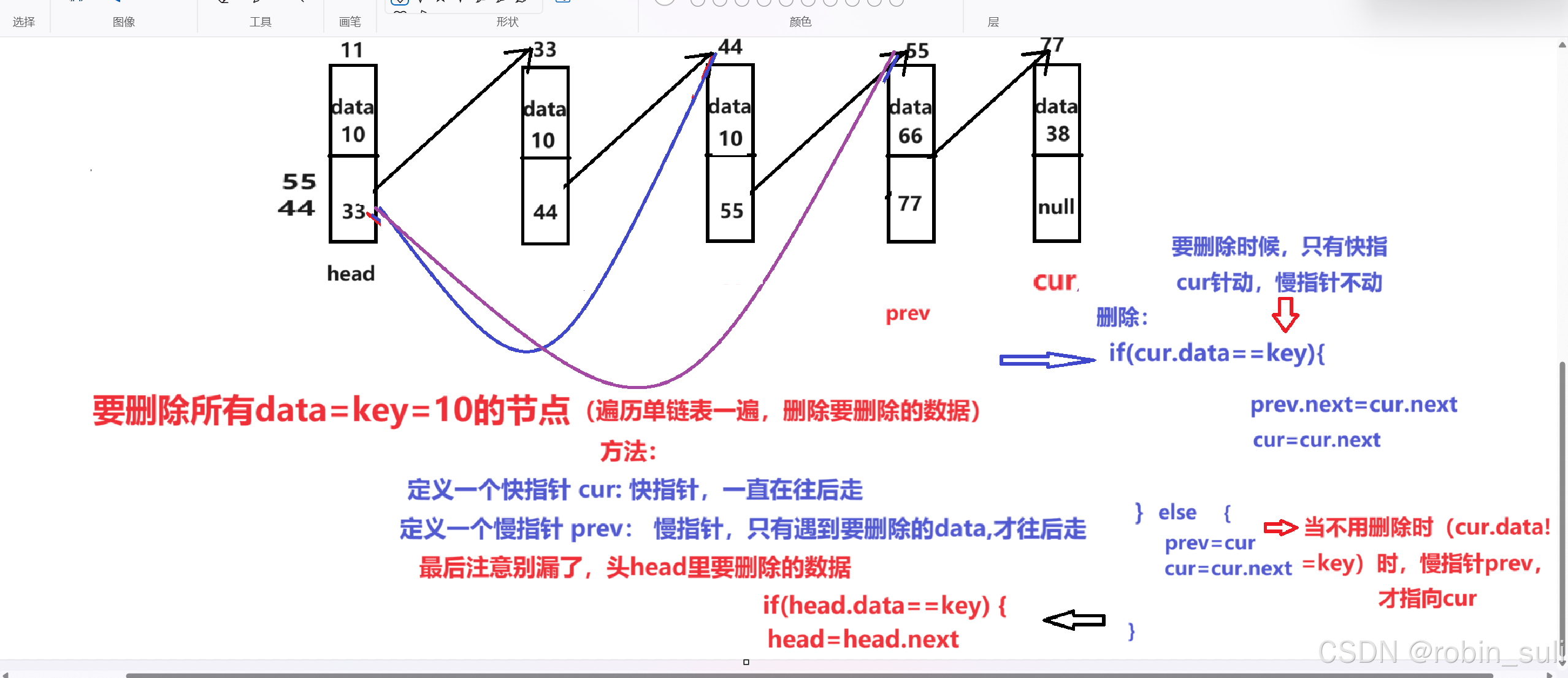
//遍历单链表一遍,删除所有值为key的节点 public void removeAllKey(int key) { /** 1.定义一个快指针 cur : cur指针一直往后走; * 2.定义一个慢指针 prev: prev指针,只有cur遇到要删除的数据时,prev指针才往后走,不然保持不动 * 3.注意最后不要漏了,head头节点 */ // 1.定义一个 cur指针 : cur指针一直往后走 // 2.定义一个 prev指针: prev指针,只有cur遇到要删除的数据时,prev指针才往后走,不然保持不动 Node cur = this.head.next;// Node prev = this.head; while (cur != null) { if (cur.data == key) { //cur.data == key,时只有cur指针都在走,因为要遍历删除数据 prev.next = cur.next; cur = cur.next; }else { //cur.data != key,两个指针都在动,prev指针,指向cur指针 prev = cur; cur = cur.next; } } // 3.注意最后不要漏了,head头节点 if (this.head.data == key) { this.head = this.head.next; } }反转一个链表
class Solution { public ListNode reverseList(ListNode head) { ListNode cur = head; if(head == null) { return null; } head = null; while(cur != null) { ListNode curN = cur.next; cur.next = head; head = cur; cur = curN; } return head; } }
2.给定一个带有头结点 head 的非空单链表,返回链表的中间结点。如果有两个中间结点,则返回第二个中间结点:
理解视频:找到链表中间节点-CSDN直播
找到链表中间节点
class Solution { public ListNode middleNode(ListNode head) { if(head == null) { return null; } ListNode fast = head;//快指针一次走2步 ListNode slow = head;//慢指针一次走一步 //条件不可以交换:(fast != null && slow.next != null),fast可能开始就为null while (fast != null && fast.next != null) { fast = fast.next.next; slow = slow.next; } return slow; } }3.将两个有序链表合并为一个新的有序链表并返回。新链表是通过拼接给定的两个链表的所有节点组成的:
理解视频:合并两个有序链表-CSDN直播
合并两个有序链表
class Solution { public ListNode mergeTwoLists(ListNode list1, ListNode list2) { ListNode headH = new ListNode(-1); ListNode tmp = headH;//tmp用来遍历两个链表 while(list1 != null && list2 != null) { //哪个节点数据小,就接在tmp后面 if(list1.val < list2.val) { tmp.next = list1; list1 = list1.next; tmp = tmp.next; }else { tmp.next = list2; list2 = list2.next; tmp = tmp.next; } } //当其中一个链表遍历完,就直接接上另一个链表的后半部分 if(list1 != null) { tmp.next = list1; } if(list2 != null) { tmp.next = list2; } return headH.next; } }4.链表的回文结构:
这里有两个点要注意:1.从后往前用slow走,因为偶数节点,fast指针会走到null,无法往前走。
2.回文时偶数情况下,A的下一个节点是slow节点,并且两个节点的val相等。这个时候就要直接返回ture
理解视频:链表的回文结构-CSDN直播
链表的回文结构
public class PalindromeList { public boolean chkPalindrome(ListNode A) { // write code here if (A == null) { return true; } // write code here ListNode fast = A; ListNode slow = A; //1.找到中间节点 while (fast != null && fast.next != null) { fast = fast.next.next; slow = slow.next; } //2.翻转链表 ListNode cur = slow.next; while (cur != null) { ListNode curN = cur.next; cur.next = slow; slow = cur; cur = curN; } //3.判断回文 //让A往后走,slow往前走直到;A.val==slow.val //注意:回文时会有偶数情况下,A的下一个节点是slow节点,并且两个节点的val相等。这个时候就要直接返回ture while (A != slow) { if (A.val != slow.val) { return false; } //到这里A.val == slow.val //A.val == slow.val前提下,偶数情况下,A的下一个节点是slow节点,并且两个节点的val相等。这个时候就要直接返回ture if (A.next == slow) { return true; } A = A.next; slow = slow.next; } return true; } }
5.编写代码,以给定值x为基准将链表分割成两部分,所有小于x的结点排在大于或等于x的结点之前:
注意:这里我的方法是,改完后,链表数据从小到大的,而做题在牛客网是,要求反过来(但是方法都一样)
理解视频:链表分割-CSDN直播
链表分割
//链表的分割 public Node partition(Node pHead, int x) { Node as = null; Node ae = null; Node bs = null; Node be = null; Node cur = pHead; while (cur != null) { if (cur.data > x) { //第一次插入 if (as == null) { as = ae = cur; }else {//第N次插入 ae.next = cur; ae = ae.next; } } else { //第一次插入 if (bs == null) { bs = be = cur; }else{//第N次插入 be.next = cur; be = be.next; } } cur = cur.next; } //当一个链表为空时,返回 if(as == null) { return bs; } //如果到这里as!= null //连接两部分 ae.next = bs; //注意,第二部分结尾不为空时,要手动把第二部分最后一个节点,手动制空 if(bs != null) { be.next = null; } //最后返回as return bs; } 6.给定一个链表,返回链表开始入环的第一个节点。 如果链表无环返回空 :
方法是:第一次相遇点,到入口点的距离,等于起始点到入口点的距离
这里我画了这个图的推到:

public class Solution { public ListNode detectCycle(ListNode head) { ListNode fast = head; ListNode slow = head; // 方法:第一次相遇点,到入口点的距离,等于起始点到入口点的距离 while(fast != null && fast.next != null) { fast = fast.next.next; slow = slow.next; if(fast == slow) { break; } } /** 1.走到这里,要么不满足{(fast != null && fast.next != null)} 就是没有环; 2. 要么就是有环 */ //没有环 if(fast == null || fast.next == null) { return null; } /** 有环:让slow以和fast以相同的速度,从起始点到入口点, fast从第一次相遇的成环点走到入口点 */ slow = head;//把slow返回起始点 while(slow != fast) { slow = slow.next; fast = fast.next; } return slow; } }
7.输入两个链表,找出它们的第一个公共结点:
方法:先找到哪个链表长,再让长的链表先走,他们的差值步,最后两个链表一起走,直到他们第一次相遇。
public class Solution { public ListNode FindFirstCommonNode(ListNode pHead1, ListNode pHead2) { //1.先分别求出两个链表的长度 ListNode pl = pHead1; ListNode ps = pHead2; int lenA = 0; int lenB = 0; while (pl != null) { lenA++; pl = pl.next; } while (ps != null) { lenB++; ps = ps.next; } //注意pl和ps,指向了null,要赋值回来 pl = pHead1; ps = pHead2; //2.求差值 int len = lenA - lenB; if (len < 0) { pl = pHead2; ps = pHead1; len = lenB - lenA;//len变为为正数 } //现在知道pl指向长的链表,ps指向短的链表 //3.操作两个链表pl和ps,长的链表(pl)先走链表的差值,然后再一起走直到相交 while (len != 0) { pl = pl.next; len--; } //两个链表分别都走,直到他们相遇 while (pl != ps) { pl = pl.next; ps = ps.next; } if (pl == null) { //pl,ps为空,也不可能相交 return null; } return pl; } }
1.写的类和包:
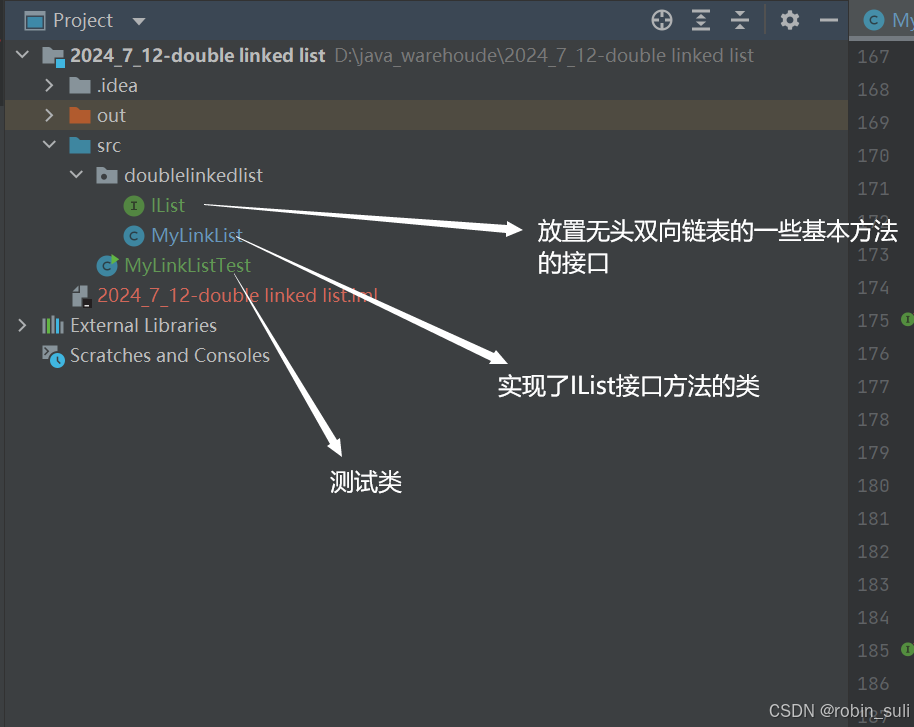 其实 无头双向链表,就比单链表多了一个,可以指向前一个节点的引用域,并且尾节点也被一个引用记录着。这样任意位置插入就不用记录节点了。2.实现:这里注意一下删除双链表指定位置Remove的节点 :可以优化一下代码,先删除头节点,之后尾节点和中间任意位置节点,有重复代码,(cur.prev.next = cur.next)可以共用;
其实 无头双向链表,就比单链表多了一个,可以指向前一个节点的引用域,并且尾节点也被一个引用记录着。这样任意位置插入就不用记录节点了。2.实现:这里注意一下删除双链表指定位置Remove的节点 :可以优化一下代码,先删除头节点,之后尾节点和中间任意位置节点,有重复代码,(cur.prev.next = cur.next)可以共用;
public class MyLinkList implements IList{ static class ListNode{ public int val; public ListNode prev; public ListNode next; public ListNode(int val) { this.val = val; } } public ListNode head;//头节点 public ListNode last;//尾节点 @Override public void addFirst(int data) { ListNode node = new ListNode(data); if (head == null) { head = last = node; }else { //所有的插入优先绑定后面 node.next = head; head.prev = node; head = node; } } @Override public void addLast(int data) { ListNode node = new ListNode(data); if (head == null) { head = last = node; }else { last.next = node; node.prev = last; last = last.next; } } @Override public void addIndex(int index, int data) { int len = size(); if (index > len || index < 0) { return; } if (index == len) { addLast(data); } if (index == 0) { addFirst(data); } ListNode cur = findIndex(index); ListNode node = new ListNode(data); node.next = cur; cur.prev.next = node; node.prev = cur.prev; cur.prev = node; } private ListNode findIndex(int index) { ListNode cur = head; while (index != 0) { cur = cur.next; index--; } return cur; } @Override public boolean contains(int key) { ListNode cur = head; while (cur != null) { if (cur.val == key) { return true; } cur = cur.next; } return false; } @Override public void remove(int key) { ListNode cur = head; while (cur != null) { if (cur.val == key) { if (cur == head) { //当只有一个节点要删除时 if (head == null) { cur.next.prev = null; } head = head.next; //删除就走人 return; }else { cur.prev.next = cur.next;//优化后,删除中间和尾巴的代码 if (cur == last) { last = cur.prev; }else { cur.next.prev = cur.prev; } //删除就走人 return; } } cur = cur.next; } } @Override public void removeAllKey(int key) { ListNode cur = head; while (cur != null) { if (cur.val == key) { if (cur == head) { //当只有一个节点要删除时,cur.next.prev = null会为空,所以加上if判断 if (head == null) { cur.next.prev = null; } head = head.next; //删除不能走人,接着删除后面。 }else { cur.prev.next = cur.next;//优化后,删除中间和尾巴的代码 if (cur == last) { last = cur.prev; }else { cur.next.prev = cur.prev; } //删除不能走人,接着删除后面。 } } cur = cur.next; } } @Override public int size() { ListNode cur = head; int len = 0; while (cur != null) { len++; cur = cur.next; } return len; } @Override public void display() { ListNode cur = head; while (cur != null) { System.out.print(cur.val + " "); cur = cur.next; } System.out.println(); } @Override public void clear() { ListNode cur = head; while (cur != null) { ListNode curN = cur.next; cur.next = null; cur.prev = null; cur = curN; } //注意head和last节点在链表中还被引用着 head = last = null; } }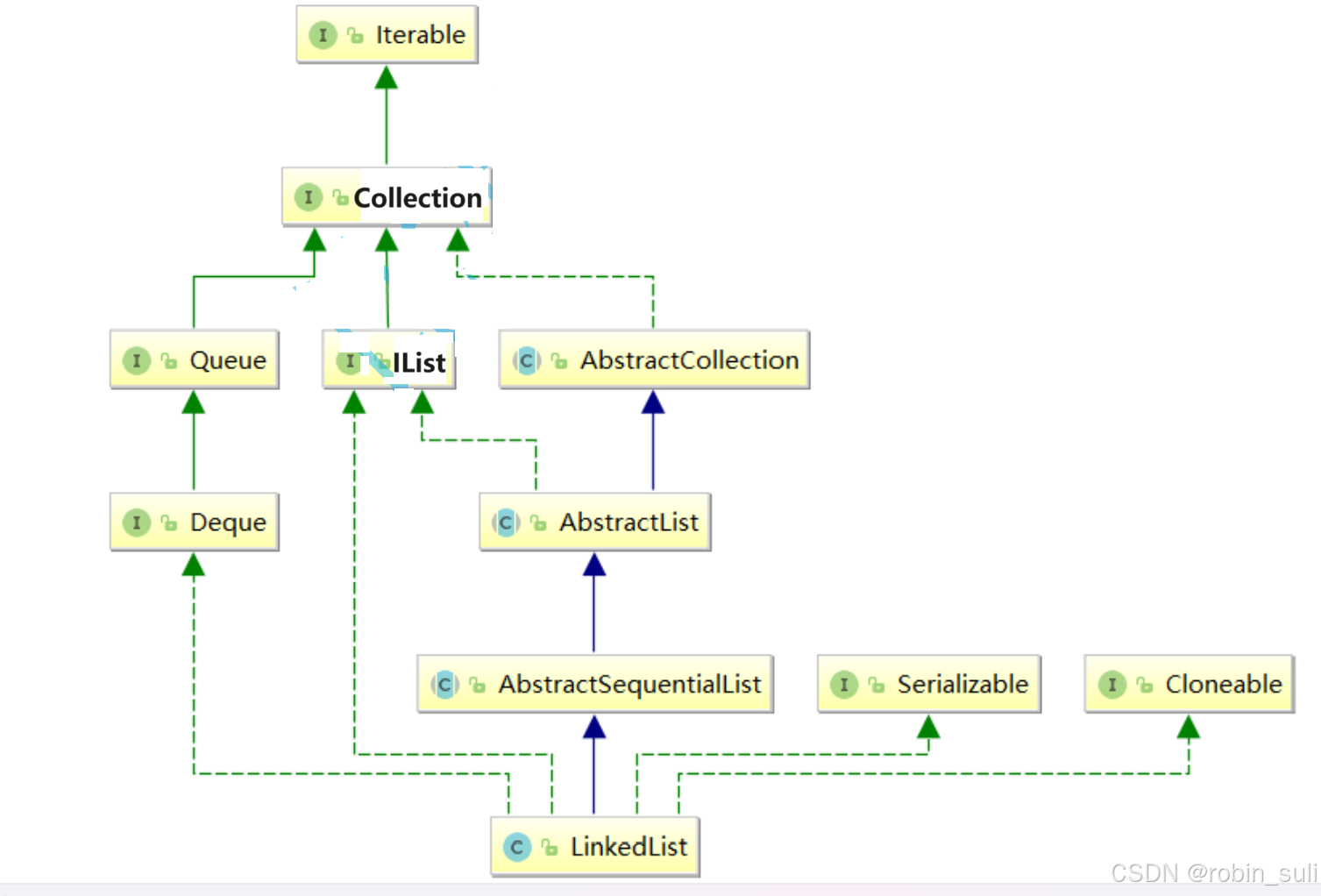
总结:1. LinkedList实现了List接口
2. LinkedList的底层使用了双向链表
3. LinkedList没有实现RandomAccess接口,因此LinkedList不支持随机访问4. LinkedList的任意位置插入和删除元素时效率比较高,时间复杂度为O(1)
5. LinkedList比较适合任意位置插入的场景
3. LinkedList也有有参数和二无参数的构造方法:
 4.方法的使用表参考:
4.方法的使用表参考:
public class Test { public static void main(String[] args) { List<Integer> list = new LinkedList<>(); list.add(1); list.add(2); list.add(3); list.add(4); System.out.println(list); ArrayList<Integer> list1 = new ArrayList<>(); list1.add(11); list1.add(12); list1.add(13); System.out.println("=============="); list.addAll(list1); System.out.println(list); } }输出:

5.LinkedList的遍历:ListIterator是Iterator的一个子类,可以专门用来打印链表
代码如下:
public class Test { public static void main(String[] args) { List<Integer> list = new LinkedList<>(); list.add(1); list.add(2); list.add(3); list.add(4); System.out.println(list); ArrayList<Integer> list1 = new ArrayList<>(); list1.add(11); list1.add(12); list1.add(13); System.out.println("foreach遍历"); for (Integer x:list) { System.out.print(x + " "); } System.out.println(); System.out.println("迭代器遍历历"); Iterator<Integer> it = list.iterator(); while (it.hasNext()) { System.out.print(it.next() + " "); } /** * ListIterator是Iterator的一个子类,可以专门用来打印链表 */ System.out.println(); System.out.println("使用迭代器遍历---正向遍历"); ListIterator<Integer> it1 = list.listIterator(); while (it1.hasNext()) { System.out.print(it1.next() + " "); } System.out.println(); System.out.println("使用反向迭代器---反向遍历"); ListIterator<Integer> it2 = list.listIterator(/*这里要传链表的长度*/ list.size()); while (it2.hasPrevious()) { System.out.print(it2.previous() + " "); } } }
六.ArrayList和LinkedList的区别:
